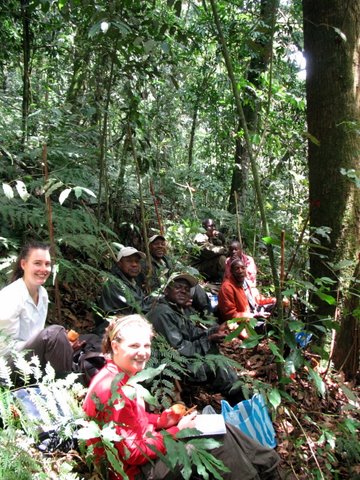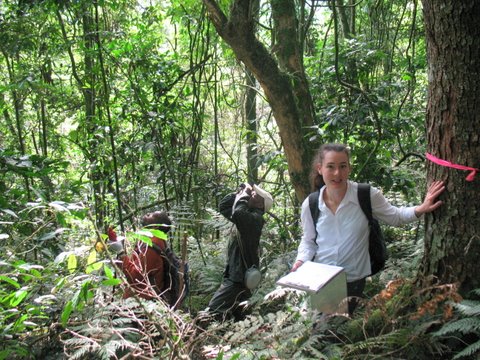|

In Bwindi
Impenetrable
National Park (Bwindi), agreements were signed between Uganda Wildlife
Authority (UWA) and local people for harvesting of certain non timber
forest products (NTFPs) in designated areas called multiple use zones.
This is made possible by a programme known as the 'Multiple Use (MU)
program' introduced to address conflicts between UWA and local
communities in 1994. Very conservative annual harvest quotas (1% of
total available and harvestable stock) were set for these plants at
first, based on a rapid vulnerability assessment. More recently, random
plots were set up in the forest and the quota reset at 3%.
From the
early start of the MU program, ITFC was tasked with monitoring the
impact of NTFP harvesting in the respective MU zones of Bwindi. A
selection of the most vulnerable plants was made for monitoring on an
annual basis, to check that harvesting was ecologically sustainable. One
of these plants is Rytigynia kigeziensis, a multi-stemmed
shrub-tree from which the bark is harvested for medicinal use.
The aim of
my study was to evaluate the effects of current bark harvest levels and
determine the potential for future harvest, using a matrix modeling
approach. Robert Bitariho, senior ITFC researcher in charge of the MU
monitoring, kindly availed the existing long term data on R.
kigeziensis and allowed me to do the 2010 monitoring with some
additional data collection.
Two areas
were compared: (1) Ruhija, at an altitude of 2000-2400m where
Rytigynia bark harvest is not officially allowed but actual harvest
is taking place at relatively high intensity, and (2) the Mpungu and
Masya MU zones, at an altitude of 1500-1800m where bark harvest is
allowed but is actually below the allowed quota.
Analysis
of the long term data sets show that the populations of R.
kigeziensis are typical of long-lived species which have been
harvested for a long time, with most individuals between 6 and 12 mm
diameter and declining numbers in larger size classes. The Ruhija
population has a larger proportion of thicker stems compared to that of
Mpungu and Masya. Bark harvest intensity varied between years and was
most abundant for thicker stems in Ruhija. Percentage Similarity index
calculations indicate that population structures remained similar over
the years of monitoring, indicating that populations were stable.
 Diameter
growth ranged from 0.3mm per year for the smallest stems to 3 mm per
year for the bigger stems in Ruhija and from 0.5 to 4mm respectively in
Mpungu and Masya. Mortality rates were low in both areas, with no
evidence of mortality due to bark harvest. Fecundity levels were
calculated from the other vital rates, assuming that the populations
were stable, because accurate recruitment data were not present. The
data did not entirely fit the requirements for matrix model
constructions. Individual stems should be identified, marked and
monitored over a longer period in order to obtain data on growth,
fecundity and mortality. In the MU program, diameter measurements were
executed on a yearly basis, but individual stems were not marked and
mortality was not recorded. Additional measurements have been made in
2010 to obtain data needed for matrix model construction, but
permanently marking all stems will be necessary to be able to improve
the models. Diameter
growth ranged from 0.3mm per year for the smallest stems to 3 mm per
year for the bigger stems in Ruhija and from 0.5 to 4mm respectively in
Mpungu and Masya. Mortality rates were low in both areas, with no
evidence of mortality due to bark harvest. Fecundity levels were
calculated from the other vital rates, assuming that the populations
were stable, because accurate recruitment data were not present. The
data did not entirely fit the requirements for matrix model
constructions. Individual stems should be identified, marked and
monitored over a longer period in order to obtain data on growth,
fecundity and mortality. In the MU program, diameter measurements were
executed on a yearly basis, but individual stems were not marked and
mortality was not recorded. Additional measurements have been made in
2010 to obtain data needed for matrix model construction, but
permanently marking all stems will be necessary to be able to improve
the models.
|



